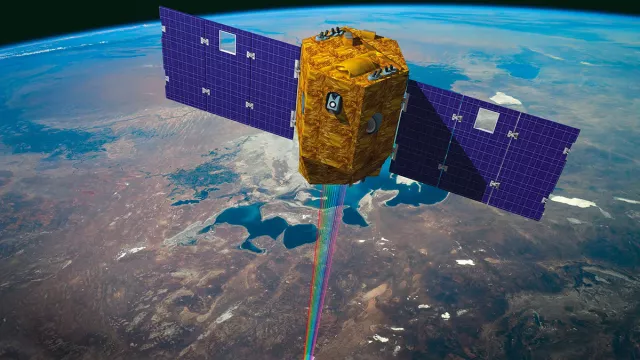Not to be confused with its planetary namesake, Venµs is a French-Israeli mission designed to provide close and regular monitoring of vegetation on Earth’s surface, notably croplands. It was launched from Kourou in 2017.
Key information
| Mission | Monitoring of Earth’s vegetation |
|---|---|
| Domain | Earth observation |
| Launch date | 2 August 2017 |
| Partners | Israel Space Agency (ISA) |
| Where | Sun-synchronous, near-polar orbit at an altitude of 720 km (science mission, 2-day revisit intervals), 410 km (technology mission) and then 560 km from March 2022 (science mission, 1-day revisit intervals) |
| Lifetime | 5 years (science mission lasting 3 years and 8 months, 18-month technology mission |
| Status | Completed |
Key figures
- 12 narrow spectral bands
- 5-to-10-m spatial resolution
- 2-day revisit interval to same point
- 260 kg: satellite mass
Key milestones
- August 2024: End of mission
- 2 August 2017: Venµs launched by Vega
- Spring 2016: Start of satellite environmental testing
- April 2015: Start of system tests
- April 2005: Venµs project kicks off
Project in brief
From 2017 to 2024, the Venµs microsatellite (Vegetation and Environment monitoring on a New MicroSatellite) delivered imagery of more than 110 areas of interest in forests, croplands and nature reserves across the globe. Images were acquired in 12 spectral bands at high spatial (5 to 10 metres) and temporal (every two days) resolutions by a camera supplied by CNES. Venµs was the first sensor in orbit combining this kind of revisit rate and spatial detail for keeping track of vegetation.
By precisely monitoring plant growth and health status, Venµs helped scientists to determine the impacts of environmental factors, human activities and climate change on Earth’s land surfaces. As a contributor to Europe’s Copernicus global environmental monitoring programme, it helped develop early-warning systems focused on crop health and water resources with a view to advancing sustainable land stewardship and food security.
Venµs’s science mission was paused for an 18-month technology mission during which its altitude was lowered to 410 kilometres to gauge the performance of a Hall-effect plasma thruster developed by the Israel Space Agency (ISA) to counter orbital decay caused by atmospheric drag.
CNES’s role
The Venµs microsatellite was a collaboration between France and Israel.
The Israel Space Agency (ISA) and CNES share responsibility for the Venµs programme. The spacecraft bus was supplied by Israel and the science payload by CNES. CNES also supplied the satellite’s superspectral camera.
CNES is in charge of the science mission centre, comprising the science data processing centre and the tasking centre at the agency’s Toulouse Space Centre.
CNES hosts the Venµs Product Distribution Server (VPDS) interfacing with the scientific community.
The data from the VENµS program are distributed by THEIA and will be available on the CNES GEODES platform.
Contacts
Project Leader, Exploitation
Agathe Moreau
E-mail: agathe.moreau at cnes.fr
Principal Investigator, CESBIO
Gérard Dedieu to 2021, then Olivier Hagolle from 2022 onwards
E-mail: Olivier.Hagolle at cnes.fr
Continental Biosphere subject matter expert
Philippe Maisongrande
E-mail: philippe.maisongrande at cnes.fr


